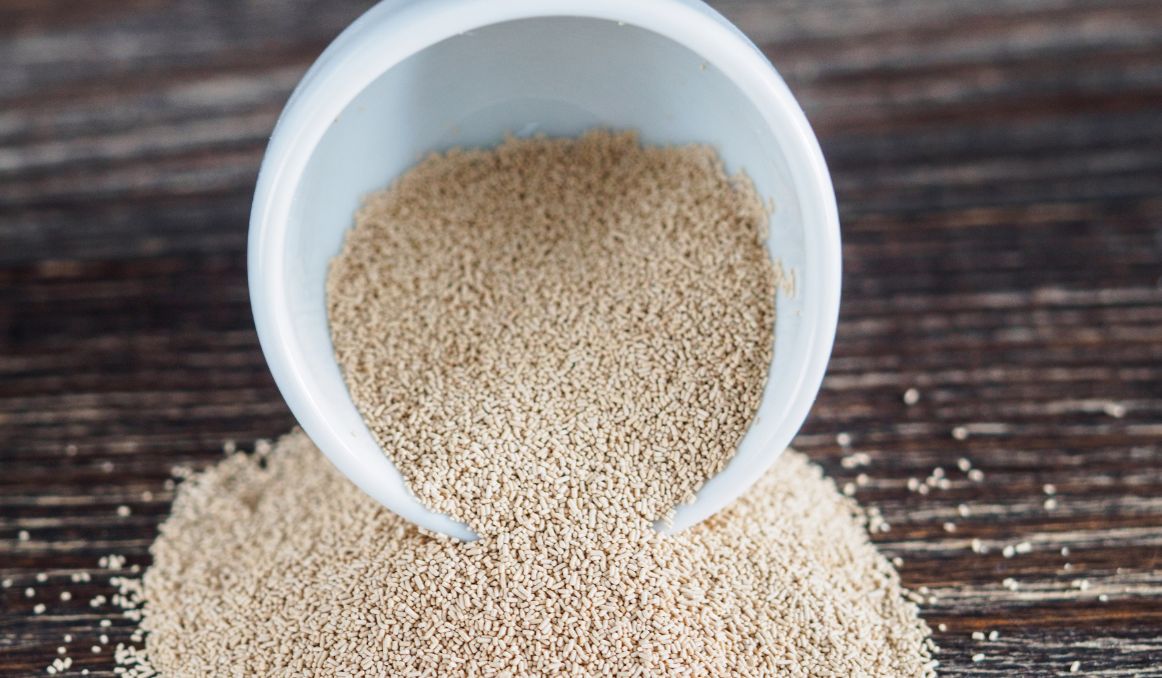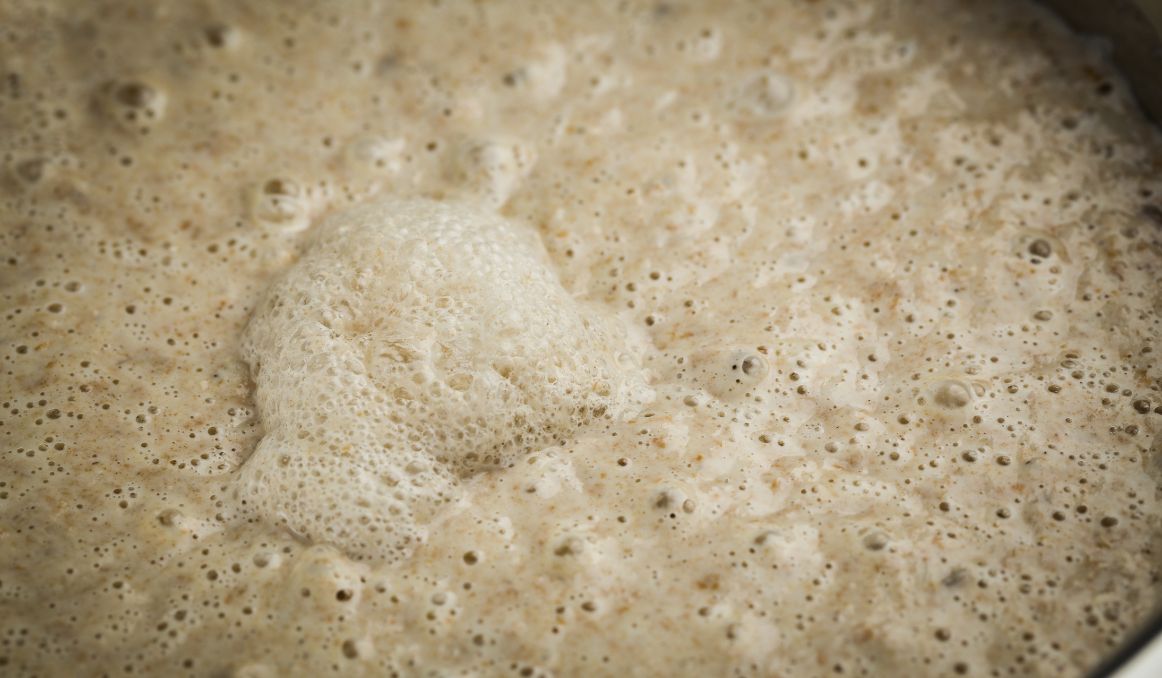During Fermentation, Yeast Produces… What Exactly?
The fermentation process can seem murky and confusing for many of us. After all, does yeast need oxygen or not? During fermentation yeast produces what exactly?
What even is yeast?
It can help to understand this living organism first, and then try to piece through the process of fermentation as it involves yeast and other organisms.
Yeast: A Brief History

Yeast is a living organism that is hundreds of millions of years old. It is a type of fungus, which is the oldest living organism on earth.
Yeast, though microscopic, is in fact a single celled, eukaryotic life form that thrives in moist, warm environments rich with oxygen.
It is often compared to bacteria as the two take up a similar amount of space, though yeast wins, not because there is more yeast than bacteria on earth but because it is slightly larger, so it takes up a bit more space.
Sugar is yeast’s primary food source and for its entire history, long before humans were ever a blip on the radar of life, yeast has been hunting for sugar.
In jungles and forests across the globe, yeast hovers in the atmosphere and on virtually every surface. When it senses sugar, it will descend and begin consuming.
Yeast uses carbohydrates, or fermentable sugars, as an energy source, and then produces alcohol and carbon dioxide as waste products.
This consumption and conversion process is what we now call fermentation.
What Is Fermentation?
Fermentation is defined as the process of breaking down sugars in the absence of oxygen, but this is actually a slightly off definition.
We use the definition in biology because of fermentation in humans.
In humans? Yes. In humans.
But the truth is that yeast and bacteria can both ferment in the presence and the absence of oxygen.
Aerobic
Aerobic fermentation is what is taking place virtually every day, all day, around the world in those jungles, forests, and deserts.
Yeast finds a fermentable sugar, consumes it, and converts those sugars to alcohol and carbon dioxide.
During the process, it will grow and reproduce, typically asexually, creating a daughter cell from its own organism that begins to grow and extend from the mother cell. The daughter cell will break off once it has reached more than 50% of the mother’s volume and begin its own fermentation cycles.
Anaerobic
There is much emphasis on anaerobic fermentation with yeast, going so far as to call what happens when yeast is deprived of oxygen a switch to alcoholic fermentation from respiratory fermentation, but again, this is a bit of a misnomer.
It is likely this emphasis is placed because the yeast does seem to go into hyperdrive when deprived of oxygen and will produce more alcohol at a higher rate than when it has access to oxygen.
The yeast is essentially stressed out and much more likely to die off more quickly, once it has produced the maximum amount of alcohol it can tolerate.
Another reason we tend to emphasize anaerobic fermentation is that it is similar to what takes place in humans.
In Humans?
When humans need energy, our bodies produce ATP, which are energy cells. The energy is originally stored in our bodies in the form of carbohydrates. Those carbohydrates are then converted to ATP on demand, as we need it.
However, when we are deprived of oxygen, like when we are out running or mountain climbing, for example, our bodies don’t have time to undergo the usual conversion, so our cells undergo a rapid process of fermentation, producing that ATP much more quickly.
It is for this reason we refer to fermentation as a process that takes place in the absence of oxygen.
Bacteria
Bacterial fermentation is similar to yeast fermentation in that it needs sugar to ferment. The difference is that it does not produce alcohol.
Bacterial fermentation is called “lactic acid fermentation,” and it results in all the wonderful, fermented foods rich in probiotics we love so much – kimchi, kombucha, pickles, and yogurt among them.
Yeast

Yeast fermentation, also called alcoholic fermentation is the kind most often referred to when we discuss fermentation, and it is what produces alcohol and carbon dioxide.
Yeast is responsible for wine, probably the first fermented beverage on earth as it was the easiest to discover.
Think about it – store some grapes in a container for a while, and eventually you’ll have some fermented grape juice, or wine, at the bottom of your container.
It is also responsible for beer, liquor, and even the biofuel ethanol that is getting so much attention in green earth circles right now.
We also have yeast to thank for bread, though we don’t typically think of the alcohol in bread, which is almost totally baked out in the oven. It is the carbon dioxide that gives us leavened – lighter, fluffier – bread.
During Fermentation Yeast Produces So Much!
Along with alcohol and carbon dioxide, yeast also produces hundreds of secondary metabolites in beer, wine, and liquor.
It is during the process of fermentation that yeast creates all of these other waste products as a simple matter of seeking energy.
These metabolites include the fermentation aromas that give your favorite beverages their fruity or floral flavors as well as varietal aromas that lend grapefruit and other citrus notes to the brews.
Indeed, some scientists contend that up to 80 percent of the aromatic compounds you love in your favorite fermented beverage are present because of yeast.
It truly is a wonder of ingredients, a lot packed into such a tiny organism, and without it we would be deprived of so many of the foods and beverages we love.
So, in answer to the question about what yeast produces, we say, “so much!” And thank goodness for that.
Cheers!
Passionate about the beer and/or wine making process? So are we! If you’re interested in finding out how you can use our technology to control fermentation and monitor your yeast, save work hours and improve the cost-efficiency of your business, drop us a line at [email protected] or check out our product pages:
- Oculyze BB 2.0 (Better Brewing) Yeast Cell Counter App + Hardware
- Oculyze FW (Fermentation Wine) Yeast Cell Counter App + Hardware
Also, you can now get access to a fully functional demo account to test our Web App. Completely free of charge and with no commitment to purchase.
Sources:
- https://www.ncbi.nlm.nih.gov/pmc/articles/PMC3497381/
- https://www.exploreyeast.com/what-is-yeast/yeast-one-of-humankinds-oldest-ingredients/
- https://www.exploreyeast.com/yeast-and-fermentation/what-is-the-role-of-yeast-in-fermentation/
Stay on top on important fermentation insights – subscribe to our monthly newsletter and receive a hand-picked selection of our most relevant articles straight to your inbox.
Never miss a beat and get real time updates with a new article each workday by subscribing our social media channels.
Instagram | Facebook | Twitter | YouTube


